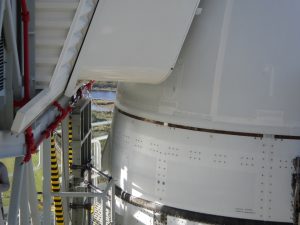Neues von der Artemis 1 - Mission:
Fri, 28 Oct 2022 20:24:55 +0000
Artemis
Teams are on track to roll the Space Launch System rocket and Orion spacecraft from the Vehicle Assembly Building (VAB) to Launch Pad 39B no earlier than Friday, Nov. 4 with first motion targeted for 12:01 a.m. EDT.
Minor repairs identified through detailed inspections are mostly completed. Preparations are underway to ready the mobile launcher and VAB for rollout by configuring the mobile launcher arms and umbilicals and continuing to retract the access platforms surrounding SLS and Orion as work is completed.
Testing of the reaction control system on the twin solid rocket booters, as well as the installation of the flight batteries, is complete and those components are ready for flight. Engineers also have replaced the batteries on the interim cryogenic propulsion stage (ICPS), which was powered up for a series of tests to ensure the stage is functioning properly. Teams successfully completed final confidence checks for the ICPS, launch vehicle stage adapter and the core stage forward skirt.
Teams are continuing to work in the intertank area of the core stage and upper section of the boosters to replace batteries. These areas will remain open to support remaining battery and flight termination system activities. Flight termination system testing will start next week on the intertank and booster and once complete, those elements will be ready for launch. Charging of the secondary payloads in the Orion stage adapter is complete.
Teams recharged, replaced and reinstalled several of the radiation instruments and the crew seat accelerometer inside Orion ahead of the crew module closure for roll. Technicians will refresh the specimens for the space biology payload at the launch pad. The crew module and launch abort system hatches are closed for the roll to the pad, and engineers will perform final closeouts at the pad prior to launch.
Teams will plan to move the crawler transporter into position outside of the VAB ahead of rolling into the facility early next week. The agency continues to target a launch date no earlier than Nov. 14 at 12:07 a.m. EDT.
Siehe auch die Originalnachricht:
Teams On Track for Artemis I Rollout to Launch Pad – Artemis

 NASA’s Space Launch System (SLS) rocket with the Orion spacecraft aboard is seen atop the mobile launcher as it arrives at Launch Pad 39B, Friday, Nov. 4, 2022, at NASA’s Kennedy Space Center in Florida. NASA’s Artemis I mission is the first integrated test of the agency’s deep space exploration systems: the Orion spacecraft, SLS rocket, and supporting ground systems. Launch of the uncrewed flight test is targeted for Nov. 14 at 12:07 a.m. EST. Photo Credit: (NASA/Joel Kowsky)
NASA’s Space Launch System (SLS) rocket with the Orion spacecraft aboard is seen atop the mobile launcher as it arrives at Launch Pad 39B, Friday, Nov. 4, 2022, at NASA’s Kennedy Space Center in Florida. NASA’s Artemis I mission is the first integrated test of the agency’s deep space exploration systems: the Orion spacecraft, SLS rocket, and supporting ground systems. Launch of the uncrewed flight test is targeted for Nov. 14 at 12:07 a.m. EST. Photo Credit: (NASA/Joel Kowsky) NASA’s Space Launch System (SLS) rocket with the Orion spacecraft aboard is seen atop the mobile launcher at Launch Pad 39B, Friday, Nov. 11, 2022, at NASA’s Kennedy Space Center in Florida. Teams began walkdowns and inspections at the pad to assess the status of the rocket and spacecraft after the passage of Hurricane Nicole.
NASA’s Space Launch System (SLS) rocket with the Orion spacecraft aboard is seen atop the mobile launcher at Launch Pad 39B, Friday, Nov. 11, 2022, at NASA’s Kennedy Space Center in Florida. Teams began walkdowns and inspections at the pad to assess the status of the rocket and spacecraft after the passage of Hurricane Nicole. The area where caulk on a seam between the Orion launch abort system’s ogive and crew module adapter detached during Hurricane Nicole.
The area where caulk on a seam between the Orion launch abort system’s ogive and crew module adapter detached during Hurricane Nicole.
 A close-up view of the area.
A close-up view of the area.